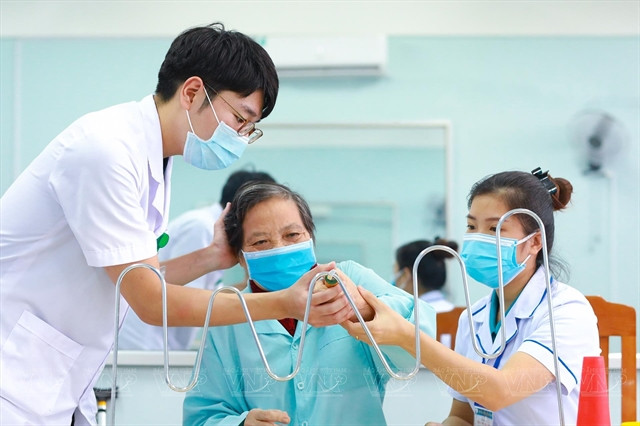 |
| Kawamura Hiroaki guides a patient through physical therapy at Quảng Trị General Hospital in central Quảng Trị Province. — VNA/VNS Photo |
Hiroaki knelt down to help the old lady, Phạm Thị Nga, put on her coat and held her walking stick firmly before taking her to the rehab room.
Hiroaki, 34, used to be a rehabilitation technician in Sapporo, Hokkaido, Japan before moving to Việt Nam to work at Quảng Trị General Hospital’s Rehabilitation Department via the Japan International Cooperation Agency (JICA)’s volunteer programme in Việt Nam.
Massaging the arms and hands of the patient, Hiroaki instructed her to move in many ways.
“You should keep your hands relaxed,” he said in Vietnamese, although he was not fluent.
Nga, 70, suffered two strokes. She has experienced three sessions of treatment and rehabilitation at the hospital with Hiroaki.
“My mother has improved a lot after having acupressure and physical therapy from Hiroaki. For my family, he’s like a family member,” said Nga's daughter.
Hiroaki is always busy. After Nga, he continued instructing other patients in their physical therapy. Most patients suffered strokes or injuries from accidents. They will receive therapy as part of a fixed schedule at the hospital in order to regain lost abilities.
Hiroaki is one of the first JICA volunteers to come to Việt Nam after months disrupted by the COVID-19 pandemic. He finished the 14-day quarantine and started working at the hospital on March 18, 2021.
All patients in the department are familiar with the Japanese technician and enjoy his treatment.
“This is my first time going abroad to live and work," said Hiroaki. "Friendly people in this country as well as the support of my Vietnamese colleagues make me feel very motivated. I’m really happy.”
“I love my job here. Everyone smiles when they meet me and makes me feel excited to come to work. I also receive support from my colleagues, from people inside and outside the hospital.”
Having 11 years of experience in rehabilitation work in Japan, Hiroaki wanted to do more than taking care of patients.
He has learnt the Vietnamese language to interact with patients and share professional experiences with Vietnamese doctors in rehabilitation treatment, such as rehabilitation techniques for acute stroke patients.
“The Vietnamese language is difficult, but I’m trying to learn and practise with colleagues and patients,” he said.
"It was not difficult for me to adapt to life in Việt Nam when colleagues, friends and neighbours are very friendly."
Phan Xuân Nam, deputy director of Quảng Trị General Hospital, said Hiroaki has shared his knowledge of advanced Japanese medicine, and procedures for caring patients.
Nam said this is the second time the hospital has welcomed JICA volunteers.
“Patients love it when Japanese volunteers come and help them," Nam said. "Vietnamese doctors and technicians also learn a lot from them.”
Hiroaki said, unlike Japan, Vietnamese people are greatly involved in the rehabilitation of their family members. In Japan, patients are covered by health insurance for a longer period of treatment than in Việt Nam.
Therefore, he suggested that the physiotherapist guide the patient’s family to practise with the patient in every period of treatment so that the patient’s health will be better improved.
Hiroaki said he doesn't have much time for homesickness. There are patients who have been discharged from the hospital but still keeping contact with and inform him of their self-medication progress.
Shimizu Akira, chief representative of JICA in Việt Nam, said the support of people who are motivated to help and connect with others via the volunteer programme is a great help. The close relationship between the people of the two countries will make the bilateral relationship stronger.
The volunteer programme has very good results, especially at the local, grassroots level, he said.
Việt Nam was one of the first countries Japanese volunteers returned to after the COVID-19 pandemic.
JICA’s Volunteer Programme was launched in Việt Nam in 1995 with volunteers to provide healthcare, rehabilitation, Japanese language teaching, communication development, sports, agriculture, tourism, and support to children and people with disabilities. — VNS